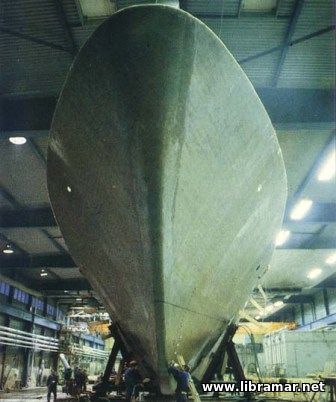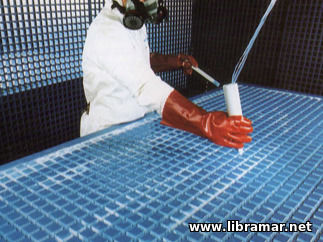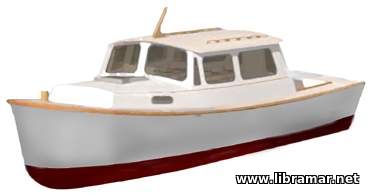Glass Reinforced Plastics in Shipbuilding

In the present article we will have a short talk about one of the non-metallic materials used for construction ship hulls. Though not used in ship building as widely as the steel, for instance, the these plastics are becoming more are more popular and therefore deserve due attention of the ship designers and shipbuilders.
Glass reinforced plastics, GRP, are a form of fiber reinforced plastics, FRP, which were introduced for marine structural applications in the 1940's in the form of Navy personnel boats. Since that time GRP have found widespread acceptance for yachts and small boats such as fishing trawlers up to 34 m in length. Although the future of glass reinforced plastics for larger ship structures is very promising, economic factors, and to some degree, questions of durability, limit their applicability.
Reinforced plastics used for ship structures are composed of glass fibers embedded in unsaturated polyester resins. Properties of GRP that are particularly useful for marine service, and have led to their extensive use for small boats, are high strength-to-weight ratio combined with good resistance to deterioration upon prolonged exposure to sea water. Lower maintenance costs for GRP hulls compensate for their relatively high initial cost as compared with steel or wood.
Although GRP have been established as useful materials for relatively small hulls, their application to larger ships is limited by several factors. The modulus of GRP is of the order of one tenth that of steel. This tends to increase GRP hull deflections to the extent that it could present serious problems in large ships in propeller shafting and piping arrangements as well as uncertain effects due to appreciable hull deflection. In addition, GRP have a tendency to creep upon prolonged exposure at high stress; this may be of special concern at points of stress concentration. Current methods of assembly are not oriented toward the production of large GRP ship hulls, and mechanized production techniques appropriate to such hulls would have to be developed.
 In addition, any consideration for larger hulls must of course recognize that GRP laminates in general use rapidly lose strength at elevated temperatures and will support combustion - this is a matter of utmost importance and shall be considered as necessary when making appropriate calculations. Today, we must say that the available GRP materials are not as yet cost effective for large ships. A study of the feasibility of a 152 m GRP cargo ship concluded that it would actually not be economically competitive with the equivalent steel ship and, in addition to that, would not meet governmental regulations relative to fire resistance. However, the report did indicate economic potential of GRP for structural components such as deck houses, hatch covers, kingposts, and bow modules, leaving some room for further development and applications of the GRP.
In addition, any consideration for larger hulls must of course recognize that GRP laminates in general use rapidly lose strength at elevated temperatures and will support combustion - this is a matter of utmost importance and shall be considered as necessary when making appropriate calculations. Today, we must say that the available GRP materials are not as yet cost effective for large ships. A study of the feasibility of a 152 m GRP cargo ship concluded that it would actually not be economically competitive with the equivalent steel ship and, in addition to that, would not meet governmental regulations relative to fire resistance. However, the report did indicate economic potential of GRP for structural components such as deck houses, hatch covers, kingposts, and bow modules, leaving some room for further development and applications of the GRP.
The high strength-to-weight ratio of GRP could make them particularly attractive for some applications in weight critical hulls such as hydrofoils or hovercraft. Considerable research effort is directed toward increasing the modulus by substituting high modulus fibers such as boron or carbon for glass fibers. Although such substitutions increase the modulus significantly, their high costs preclude their use for general hull applications.
Note that there is another article on the non-ferrous materials available on our website and that one is devoted to the concrete including various types, and their application in the ship construction. Here it is.
The "Read Later" function allows you to add material to this block with just one click. Just click on the icon and read the articles that interest you at any convenient time.


